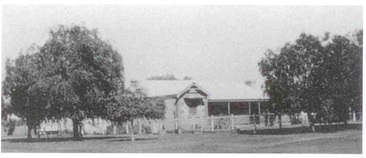Your Hosts....
Robert and Leanne Lefroy are the current managers at Nalbarra Station. They are great lovers of the outdoors and the outback and look forward to sharing that passion with you.
Nalbarra runs up to 9,000 meat sheep on the property, so their is plenty to learn as a visitor to this pastoral region.
Nalbarra runs up to 9,000 meat sheep on the property, so their is plenty to learn as a visitor to this pastoral region.
A little Nalbarra History....
 Old Nalbarra Homestead destroyed in 1948
Old Nalbarra Homestead destroyed in 1948
The leases which formed Nalbarra Station were taken up by Francis Pearse between 1895 and 1897. The original name given to the property was Nalbarralla, which means 'a spring or pool of water.' Jimmy Jenner was the manager of the station totaling some 321,000 acres, up until about 1908, when Nelson Pearse (son of Francis) took over the management.
Of these early years spent on Nalbarra, Colin Pearce (son of Nelson) recollects:
Of these early years spent on Nalbarra, Colin Pearce (son of Nelson) recollects:
I can remember when "Nalbarra" had horse, camel and donkey teams to cart wool to "Yoweragabbie" 33 miles taking two to three days and bringing back stores, chaff and so on. We would then take some (of the stores) across to "Nardee", 45 miles. When school holidays were on, I used to go to Nalbarra and drive camel teams with the teamster.
We had shet-land ponies and used to muster stock and ride all day with a saddle and no stirrups. Camels are very inquisitive and used to chase us when we were out riding, and frighten us, so we would gallop home. When I lived at "Nalbarra" we had governesses. They used to teach us, and any of the native boys and girls. There were no correspondence lessons until later on.
Jean and Pat Lockyer took up the management of Nalbarra in 1927.
In the 1930's a large drought covered most of the Murchison district and the sheep of Nalbarra were moved to Mullewa and Mingenew on agistment. The sheep were driven to the Yoweragabbie siding and loaded into rail trucks. Only 80 sheep remained on Nalbarra until the seasons improved.
Sadly, in 1948 following the breaking of the drought, some 10 to 16 inches of rain fell in a few days causing flooding which washed away the homestead, shearing quarters and coursed through the wool shed. Thirty miles of fencing and 3,000 sheep were lost. Only 1 flood has since reached the same level. The homestead walls, which had been built using clay brick (ant hills) collapsed. A new homestead was built using cement bricks made on the property, a new shearers quarters was built also which all exist now at Nalbarra.
3 generations of the Lockyer family worked and lived on Nalbarra from 1927 to 1983.
History taken from “Drawn to Mt Magnet” By Karen Morrissey and Lorna Day available at the Mount Magnet Visitors Center.
In the 1930's a large drought covered most of the Murchison district and the sheep of Nalbarra were moved to Mullewa and Mingenew on agistment. The sheep were driven to the Yoweragabbie siding and loaded into rail trucks. Only 80 sheep remained on Nalbarra until the seasons improved.
Sadly, in 1948 following the breaking of the drought, some 10 to 16 inches of rain fell in a few days causing flooding which washed away the homestead, shearing quarters and coursed through the wool shed. Thirty miles of fencing and 3,000 sheep were lost. Only 1 flood has since reached the same level. The homestead walls, which had been built using clay brick (ant hills) collapsed. A new homestead was built using cement bricks made on the property, a new shearers quarters was built also which all exist now at Nalbarra.
3 generations of the Lockyer family worked and lived on Nalbarra from 1927 to 1983.
History taken from “Drawn to Mt Magnet” By Karen Morrissey and Lorna Day available at the Mount Magnet Visitors Center.